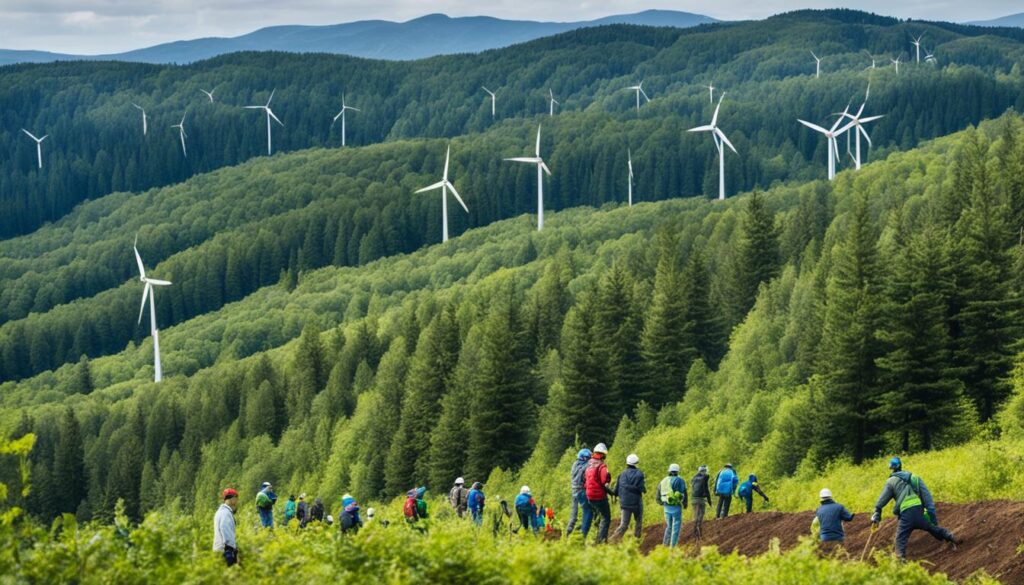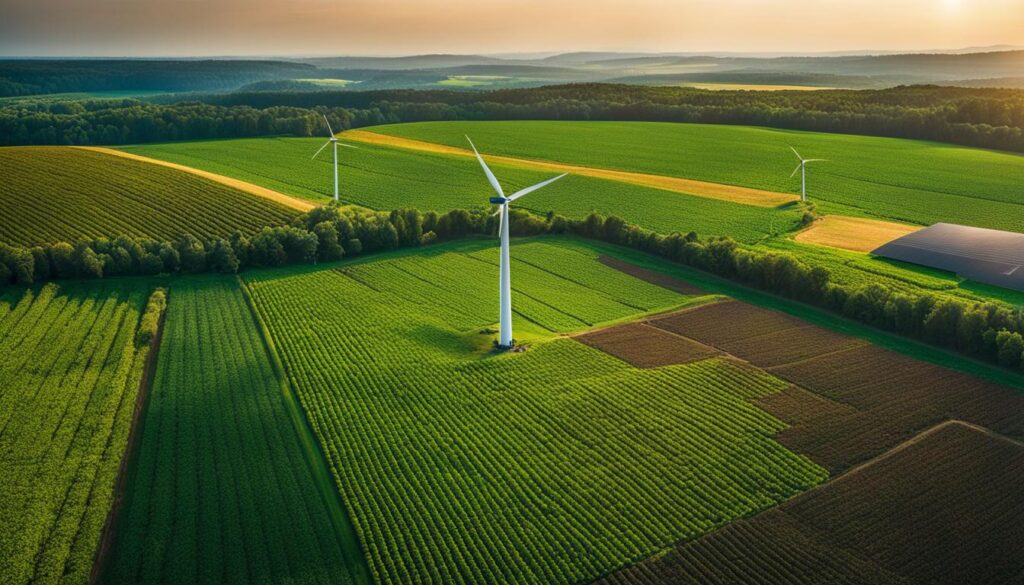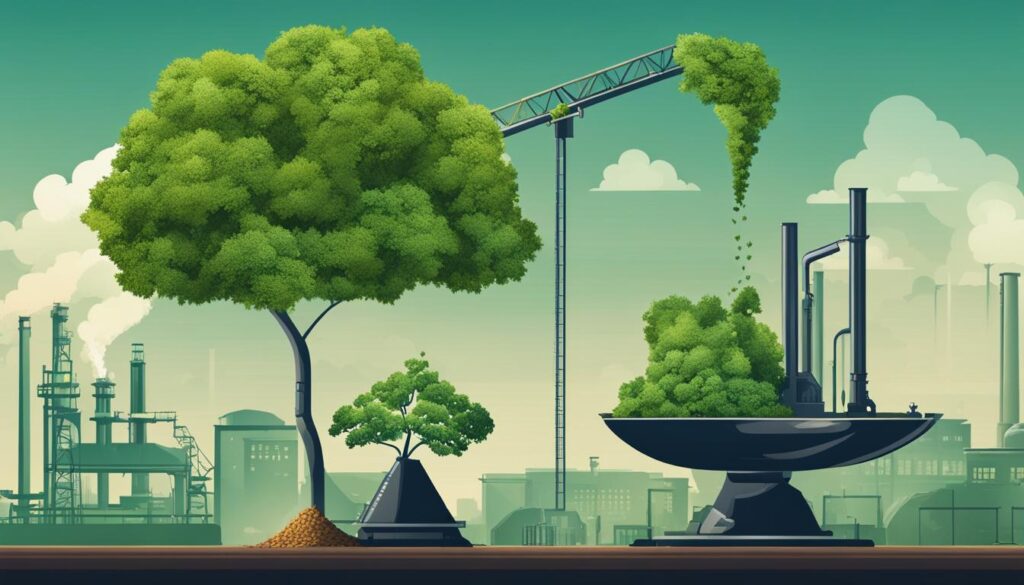Carbon offsetting has gained traction in recent years as one of the most effective ways to combat climate change. But what exactly is carbon offsetting and how does it work? In this section, we will explore the definition of carbon offsetting and the process that drives it, arming you with the knowledge needed to make informed decisions about offsetting your carbon footprint. With this deeper understanding of carbon offsetting, you can take proactive steps towards reducing your environmental impact.
Carbon offsetting is the process of balancing carbon emissions by investing in projects that reduce or absorb an equivalent amount of carbon from the atmosphere. Through this process, organizations and individuals can take responsibility for their carbon footprint and contribute to global emissions reduction efforts. But how does this process work? Let’s delve deeper into the mechanism of carbon offsetting.
What is Carbon Offsetting?
Carbon offsetting is the process of compensating for the carbon emissions created by an individual, organization, or activity by investing in an equivalent reduction of carbon emissions elsewhere. Essentially, carbon offsetting involves balancing out carbon emissions by investing in projects that reduce emissions, such as reforestation or renewable energy initiatives, to offset the emissions created.
Through carbon offsetting, individuals and organizations can take responsibility for their carbon footprint and make a positive impact on the environment. This not only contributes to the fight against climate change but also enables companies and individuals to adopt a more sustainable and socially responsible approach.
The image above illustrates the concept of carbon offsetting visually, emphasizing the balance between emissions and emissions reduction created by carbon offsetting projects.
The Carbon Offsetting Process
Carbon offsetting aims to reduce the impact of greenhouse gas emissions on the planet. The offset process involves several critical steps that ensure maximum effectiveness.
The first step is to measure the carbon footprint of a given activity or product. This step involves assessing the amount of carbon dioxide and other greenhouse gases released during the process.
The second step involves identifying potential carbon offset projects that can address the emissions generated by the activity. These projects can include renewable energy initiatives, reforestation programs, or energy efficiency projects.
The third step is to finance the selected offset project. This step involves investing in the project to ensure its successful implementation.
Finally, it is essential to monitor and track the progress of the carbon offset project to ensure it is yielding the desired outcomes. This step involves regular assessment and reporting to evaluate the effectiveness of the offset project.
Carbon offset projects come in various forms and sizes. They can range from small-scale local initiatives to large-scale international programs. Some of the key elements of carbon offset projects include:
- Verification of emissions reduction
- Additionality – The project must result in additional emissions reductions that would not have happened without the offset project
- Permanence – The project must ensure long-term emissions reductions
- Leakage – The project must not result in increased emissions in other areas
- Transparency – The project’s emissions reductions must be clearly and accurately measured and reported
Certification bodies, such as the Verified Carbon Standard and the Gold Standard, provide guidelines for the development and verification of carbon offset projects.
Carbon Offset Project Example: Reforestation
Reforestation involves planting trees or restoring degraded forests to absorb carbon dioxide from the atmosphere. The carbon sequestered by the trees offsets the emissions generated by activities such as transportation, energy use, and production.
| Benefits of Reforestation Projects | Challenges of Reforestation Projects |
|---|---|
|
|
Reforestation projects can have a significant impact on reducing carbon emissions while also providing numerous ecological and social benefits.
Benefits of Carbon Offsetting
Carbon offsetting offers numerous benefits to the environment, society, and businesses. Here are some of the key advantages:
- Reducing carbon footprint: Carbon offsetting enables individuals and organizations to reduce their carbon footprint, thus mitigating their impact on the environment.
- Preserving biodiversity: Carbon offset projects such as reforestation help preserve biodiversity by promoting the growth of natural habitats for flora and fauna.
- Supporting sustainable development: Carbon offsetting supports sustainable development by promoting the use of renewable energy sources and low-carbon technologies.
- Generating economic benefits: Carbon offset projects can also support economic growth by creating job opportunities and promoting innovation in the clean energy sector.
By offsetting carbon emissions, individuals and organizations can contribute to a more sustainable future for all. The positive impact of carbon offsetting goes beyond environmental benefits, promoting sustainable economic growth, social responsibility, and technological innovation.
Carbon Offsetting Methods
Carbon offsetting methods refer to the techniques used by organizations to reduce their carbon emissions and uphold sustainable environmental practices. Here are some of the most common carbon offsetting methods:
| Method | Description |
|---|---|
| Renewable Energy Production | Utilizing renewable resources such as solar, wind, hydro and geothermal energy to generate power. |
| Reforestation and Afforestation | Planting trees and creating new forests to restore ecosystems, enhance biodiversity and sequester carbon from the atmosphere. |
| Energy Efficiency Measures | Implementing measures to reduce energy consumption, maximize energy efficiency, and lower carbon emissions. |
| Methane Capture and Destruction | Capturing methane gas, a potent greenhouse gas, from waste and agricultural processes, and destroying it to prevent its release into the atmosphere. |
By adopting these approaches, individuals and organizations can make significant strides in reducing their carbon footprint and contributing to a healthier planet.
Carbon Offset Projects
In order to combat climate change, it is important to support carbon offset projects that help reduce greenhouse gas emissions. There are various types of carbon offset projects that you can support, all with different environmental and social benefits.
Reforestation
Reforestation involves planting new trees in areas where forests have been depleted or destroyed. Trees absorb carbon dioxide from the atmosphere as they grow, making this an effective method of carbon offsetting. Furthermore, reforestation provides habitats for wildlife and promotes soil stability.
Renewable Energy
Renewable energy projects involve generating energy from clean sources, such as wind or solar power, which have low carbon emissions. Supporting these initiatives can reduce our dependence on fossil fuels and help combat climate change. Furthermore, renewable energy projects can create job opportunities and promote economic growth.
Energy Efficiency
Energy efficiency projects involve upgrading buildings and infrastructure to reduce energy consumption. This can be achieved through measures such as insulation, installing energy-efficient appliances, and improving transportation infrastructure. Energy efficiency projects can also provide cost savings and improve quality of life.
“By supporting carbon offset projects, you can make a positive impact on the environment while also contributing to social and economic development.”
Understanding Carbon Offsetting Standards
Carbon offsetting relies on the credibility of recognized frameworks and standards. These mechanisms ensure effectiveness, transparency, and accountability, eliminating risks of fraud and misguided investments. The carbon offsetting process involves specific standards and certifications, some of which include:
| Standard/Certification | Description |
|---|---|
| Verified Carbon Standard (VCS) | A leading global standard that oversees carbon offset projects in several sectors. |
| Gold Standard | A framework that incorporates sustainability, social responsibility, and environmental protection in carbon offset projects. |
| Climate, Community, and Biodiversity Standards (CCB Standards) | A framework that promotes projects contributing to climate change, community development, and biodiversity conservation. |
These standards and certifications aim to ensure adequate monitoring, reporting, and verification of carbon offset projects. They also facilitate the generation of carbon credits, which prove that the project has offset the equivalent amount of greenhouse gases as claimed.
Carbon offsetting standards provide credibility and transparency to the process, allowing individuals and organizations to make informed decisions regarding their carbon neutrality goals.
Evaluating the Impact of Carbon Offsetting
Carbon offsetting offers numerous benefits to the environment, society, and businesses, but it’s essential to measure its effectiveness to ensure its success in reducing greenhouse gas emissions. Here are some of the criteria used to evaluate the impact of carbon offset projects:
- Emissions Reduction: The primary purpose of carbon offsetting is to reduce emissions. Projects are evaluated based on their actual emissions reduction compared to what would have been emitted without the project.
- Additionality: For a project to qualify for carbon offsetting, it must be additional, meaning that it wouldn’t have happened without the funding from carbon credits. Additionality is evaluated by assessing the ability of the project to proceed without the credits.
- Permanence: Carbon projects must guarantee that carbon is permanently removed or reduced and won’t re-enter the atmosphere anytime in the future. The risk is evaluated based on the project design, implementation, and management.
- Verification: Carbon offset projects must undergo independent third-party verification to ensure its legitimacy and transparency. Verifiers evaluate the project’s design, implementation, and management to ensure that it meets the carbon offsetting standards.
- Co-benefits: Carbon offset projects can deliver co-benefits, such as social and environmental benefits in addition to emissions reduction. The co-benefits are evaluated based on their contribution to sustainable development, including poverty reduction, gender equality, and biodiversity conservation.
Evaluating the impact of carbon offsetting is a crucial step towards ensuring the success and effectiveness of such initiatives. By setting measurable criteria, stakeholders can assess the efficiency of projects and measure their contributions towards mitigating climate change.
Implementing Carbon Offsetting Strategies
Carbon offsetting is an effective way to reduce your carbon footprint. To get started on implementing carbon offsetting strategies, it is important to understand the process of carbon offsetting. You can start by calculating your carbon emissions and identifying the carbon offset projects you want to support. Here’s a carbon offsetting guide to help you:
Calculate your Carbon Footprint
Calculating your carbon footprint is the first step towards reducing it. Use an online carbon footprint calculator to determine your carbon emissions from sources such as transportation, energy use, and waste. Once you have calculated your carbon footprint, you can learn about the carbon offset projects that align with your values and goals.
Identify Carbon Offset Projects
Carbon offset projects include initiatives such as renewable energy, reforestation, and energy efficiency programs. By selecting the projects that align with your values and goals, you can support initiatives that have a positive impact on the environment. To ensure that the projects are trustworthy and legitimate, look for carbon offsetting standards and certifications such as the Verified Carbon Standard and the Gold Standard.
| Carbon Offset Projects | Description |
|---|---|
| Sustainable Agriculture | Implementing regenerative farming practices to reduce GHG emissions, increase soil health, and promote biodiversity. |
| Renewable Energy | Investing in clean energy projects such as wind, solar, and hydropower to reduce dependence on fossil fuels. |
| Energy Efficiency | Implementing energy-efficient practices such as LED lighting and insulation to reduce energy consumption and related carbon emissions. |
| Forestry and Land Use | Protecting and restoring forests, which absorb carbon dioxide from the atmosphere, and improving land management practices to promote biodiversity and ecosystem services. |
Select a Carbon Offset Provider
After identifying your carbon offset projects, select a carbon offset provider to contribute to the projects. Look for providers that have a strong reputation and offer detailed information about their carbon offset projects. Some reputable carbon offset providers include TerraPass, Carbonfund.org, and ClimatePartner.
Reassess and Refine
After implementing your carbon offsetting strategies, continue to monitor your carbon emissions and reassess your approach as necessary. Your carbon offsetting strategy should be a continuous process of refining and improving over time to maximize its effectiveness in reducing your carbon footprint.
By following this carbon offsetting guide and taking proactive steps towards reducing your carbon footprint, you can contribute to a more sustainable future for the planet and combat climate change.
The Future of Carbon Offsetting
As the world continues to prioritize sustainability, carbon offsetting is likely to become even more critical in the future. With the rise of environmental consciousness, individuals and organizations alike are taking proactive measures to reduce their carbon footprint, and carbon offsetting offers a way to make meaningful progress.
So, how does carbon offsetting work in the future? One emerging trend is the increased adoption of blockchain technology to improve transparency and reduce fraud in carbon offsetting transactions. By leveraging distributed ledgers, blockchain enables better tracking of carbon offset credits, ensuring that each credit represents a legitimate reduction in carbon emissions.
Another future possibility is the development of new and innovative carbon offset projects. For example, scientists are exploring the feasibility of using seaweed as a carbon sink, a technology that could revolutionize the way we approach carbon offsetting.
Regardless of how carbon offsetting evolves, one thing is certain: its role in addressing climate change will only become more critical. As individuals and organizations continue to work towards a sustainable future, carbon offsetting offers an effective way to reduce environmental impact and promote a healthier planet.
Conclusion
Now that you have a comprehensive understanding of carbon offsetting, you can take proactive steps towards reducing your carbon footprint and combating climate change. By offsetting your carbon emissions, you can contribute to the positive impact of the environment, society, and businesses.
Remember that carbon offsetting is just one part of a broader sustainability strategy. It is essential to incorporate other sustainable practices into your lifestyle, such as reducing waste, conserving energy, and using environmentally friendly products.
Together, we can make a significant impact on the environment and create a more sustainable future for generations to come.

















































